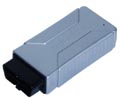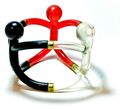- AHL components
- |
- Adaptive Headlights
- |
- BMW Electronic Systems
- |
- Technical Info
- |
- Car Tech Info
- |
- MicroTronik
Adaptive Headlights (AHL)
The following components and control units provide input signals for the adaptive headlights system:
- Light switch
The switch for side lights and dipped beam headlights differs according to equipment level (adaptive headlights, automatic headlights, and automatic or manual headlight beam adjustment). For adaptive headlights, the light switch must be set to position ((A) = Automatic).
- Direction indicator/main beam switch
Touching the switch forwards or backwards switches the main-beam headlights on/off. The adaptive headlights function operates both with dipped beam and with main-beam headlights.
- Steering column switch cluster
The steering column switch cluster control unit passes the signals from the direction indicator/main beam switch via the SGM (safety and gateway module) to the light module.
Signal path: SZL To byteflight To SGM To K-CAN To LM
(Steering column switch cluster To byteflight To Safety and gateway module To K-CAN To Light module)
- Ride-height sensors
If the (Adaptive headlights) option is fitted, the signals from the ride-height sensors are read by the AHL control unit (adaptive headlights control unit).
The AHL control unit also controls the automatic headlight-range adjustment.
The Hall-type sensors on the front and rear suspension supply the input signals for the automatic headlight-range adjustment (adjustment of headlight beam angle in order to compensate for changes in vehicle fore/aft inclination due to such things as variations in payload and braking/accelerating under extreme handling conditions).
- Brake light switch
If the (Adaptive headlights) option is fitted, the signals from the brake light switch are read by the adaptive headlights control unit (see (Ride-height sensors) above).
In addition, the brake light switch signal is also an input signal for the automatic headlight-range adjustment.
- Zero-position sensor
For the aim setting of the headlight positioner modules:
The zero-position sensor in the headlight positioner module supplies a signal indicating the horizontal-aim setting of the headlights.
- DME (Digital engine electronics)
The adaptive headlights function is only activated when the engine is running (provided the other conditions for activation are also satisfied, e.g. ambient darkness).
- EGS control unit (transmission control unit):
When reverse gear is engaged, the adaptive headlights function is deactivated.
- Rain-light sensor for automatic headlights function
The rain-light sensor measures the ambient light conditions outside the vehicle.
In semi-darkness, the rain-light sensor sends the request (Switch on dipped beam headlights) to the light module.
In complete darkness, the adaptive headlights function is also activated.
- Steering angle sensor and DSC sensor
The steering angle sensor and DSC sensor (DSC = Dynamic Stability Control) provide signals for the adaptive headlights function dependent on vehicle road speed:
· Vehicle speed 30 km/h or under:
The adaptive headlights function is controlled on the basis of the information from the steering angle sensor (in the steering column switch module).
· Vehicle speed between 30 km/h and 50 km/h:
At speeds between 30 km/h and 50 km/h, there is a gradual changeover from analysis of steering angle sensor signals to analysis of yaw rate sensor signals (in the DSC sensor).
· Vehicle speed over 50 km/h:
At speeds upwards of 50 km/h, the signals from the yaw rate sensor (in the DSC sensor) form the primary basis for control of the adaptive headlights function.
Those limits are dependent on the programming.
The signals from the other sensor in each case are taken into account as follows:
· Less than 50 km/h, steering angle sensor definitive: function of yaw rate sensor:
At speeds under 50 km/h, the signals from the yaw rate sensor are taken into account if the vehicle drifts, skids or loses sideways grip.
If the vehicle drifts, skids or loses sideways grip, the adaptive headlights function is deactivated. The headlights then return to the straight-ahead position.
· More than 50 km/h, yaw rate sensor definitive: function of steering angle sensor:
At speeds over 50 km/h, the steering angle sensor performs the following function for the adaptive headlights:
The steering angle sensor is used to predict the vehicle course. The vehicle course desired by the driver is detected before the DSC sensor signals a change of direction.
The signal from the steering angle sensor is filtered so that short, sharp back-and-forth steering wheel movements do not have an effect on the adaptive headlights.
The following control units are involved in the adaptive headlights system:
- AHL control unit
- Stepper motor controllers (SMC)
The stepper motor controllers are the control units that control the stepper motors that alter the aim of the headlights.
- Light module
The light module controls and monitors all vehicle lights. Information is transmitted and received via the K-CAN data bus. If the option (Bi-xenon headlights) is fitted, the light module analyses faults on the bi-xenon headlights.
The light module also controls the indicator lamp for the adaptive headlights (on the light switch).
- Bi-xenon control unit
The bi-xenon control unit controls and monitors the function of the bi-xenon headlights.
The following components are controlled:
- Stepper motors for the adaptive headlights in the headlight units.
The stepper motors are in the positioner modules for the bi-xenon headlights.
The stepper motors are controlled by the AHL control unit.
The stepper motors adjust the vertical and horizontal aim of the headlights (vertical aim for automatic headlight-range adjustment and horizontal aim for the adaptive headlights function; vertical = up and down, horizontal = side to side).
- Green indicator light on the light switch
The green indicator light next to the (A) for (Automatic) for the automatic headlights/adaptive headlights have two display functions:
· LED permanently lit: The LED remains continuously lit when the automatic headlights or adaptive headlights function is switched on.
· LED flashing: The LED flashes if there is a fault in the system.
The green indicator lamp (LED) is controlled by the light module.
is one of the best Professional scan tools to for BMW; Autohex allows you to diagnose, code, program/flash ecus, replace with used ECUs, and add new keys for BMW. For more information: BMW Scan Tool
BMW Key Programming by HTag Pro, All keys lost


